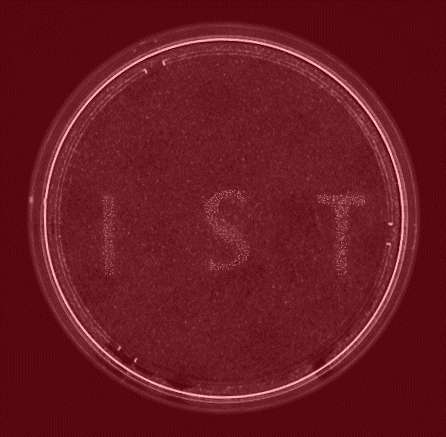Enlightening cancer cells

Joint EMBO Journal paper by IST Austria and Vienna Medical University groups on engineered cell surface receptors activated by light. Small algal protein domains serve as synthetic light sensors in human cells. First application of optogenetics to cancer research.
Harald Janovjak, Assistant Professor at IST Austria, together with Michael Grusch, Associate Professor at the Institute of Cancer Research of the Medical University of Vienna, "remote-controlled" the behaviour of cancer cells with light, as reported this week in EMBO Journal. This work is the first application of the new field of optogenetics to cancer research.
To understand the dynamics of cellular signaling, researchers need to activate and inactivate membrane receptor proteins, which serve as relays between a cell's outside and inside world. Ideally, this activation occurs on short timescales (seconds to minutes) and in targeted locations (micrometers to millimeters). However, such a high level of precision in activation cannot be achieved with current pharmacological and genetic methods. Optogenetics uses light to control cell activity, and has the advantage that light can be applied and removed precisely both in space and time. Janovjak, Grusch and colleagues re-engineered receptor tyrosine kinases (RTKs), essential cell surface receptors that sense growth factors and hormones, to be under the control of light.
When a signaling molecule binds to RTKs at the cell surface, two receptors bind to each other in a process called dimerization. This process activates signaling in the cell. Janovjak, Grusch and colleagues linked those parts of mammalian RTKs that activate cell signaling to a light-oxygen-voltage-sensing domain, a reversible light sensor that they identified in a yellow-green alga. In the engineered receptors, the dimerization step and subsequently cell signaling can now be turned on and off by light as the algal proteins sense light and bind to each other. In cancer cells, activation of the engineered receptors causes changes in cell morphology, proliferation and gene expression, characteristic of increased cancer malignancy. In blood cells, activation leads to cell sprouting, typical of the formation of new blood vessels.
The development of RTKs regulated through light-activated dimerization by Janovjak and Grusch is the first instance of light-activated dimerization of mammalian receptors. The engineered receptors can be precisely controlled by a light intensity easily achieved in microscopes and in animal models. The newly developed receptors trigger complex cellular programs in both cancer and blood endothelial cells. These cells represent new models in which behavior is under light control and which can, for instance, be used for new methods to identify drugs. In contrast to cancer, where uncontrolled activation of cell signaling results in features linked to malignancy, light activation of signaling may rescue cell survival and function in degenerative disease.
More information: EMBO Journal, emboj.embopress.org/content/ea … 06/27/embj.201387695

















